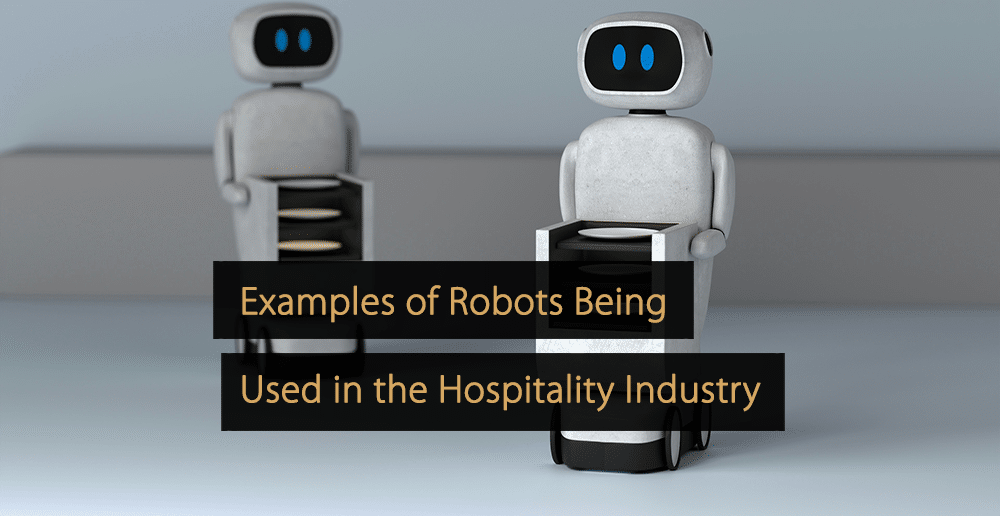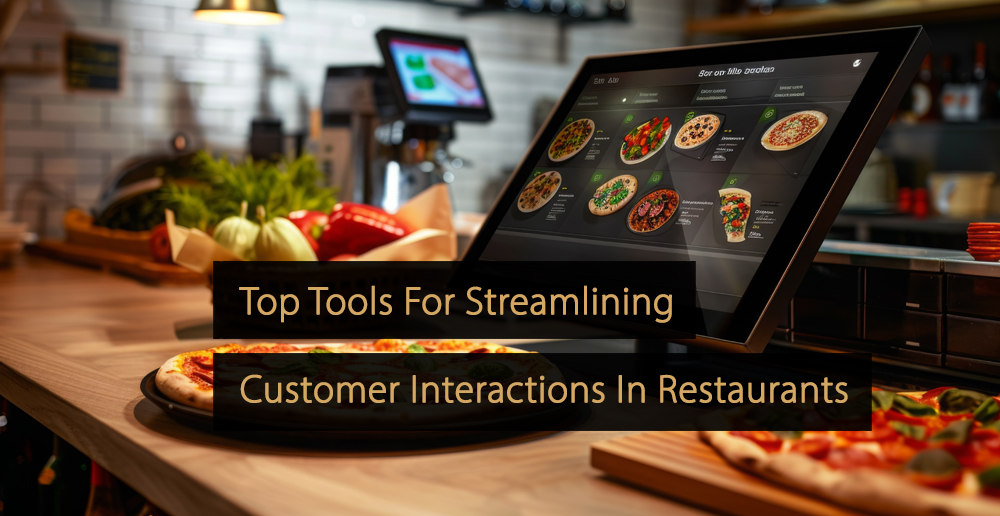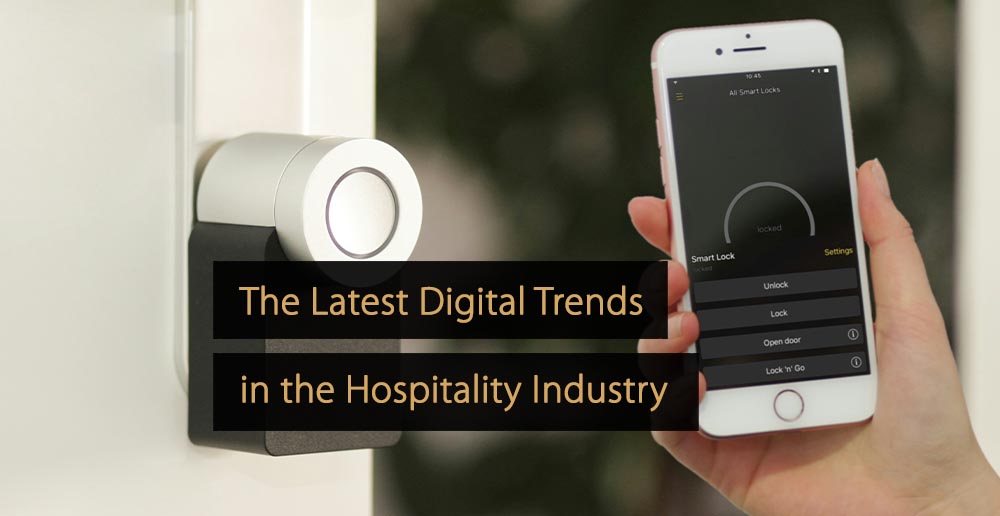A crucial part of running a successful restaurant involves investing in the best technology. However, to do this, you need to build an understanding of broader restaurant technology trends. In this article, you can learn about the latest restaurant tech trends, like innovations in POS systems, contactless payments, virtual reality, QR codes, and more.
Table of Contents:
- What is the Restaurant Industry?
- Why is it Important to follow the Latest Restaurant Technology Trends?
- The Latest Restaurant Technology Trends of 2026 You Should Know About
- 1. Autonomous Meal Delivery
- 2. Table Booking and Reservation Software
- 3. Robotic Meal Prep
- 4. Artificial Intelligence in Restaurant Technology
- 5. Augmented Reality Menus
- 6. Digital Inventory Tracking
- 7. Virtual Reality Onboarding
- 8. Digital Kitchen Display Screens
- 9. Air Purification Technology
- 10. Restaurant Chatbots
- 11. Blockchain Technology
- 12. The Internet of Things
- Important On-Going Restaurant Technology Trends
- Restaurant Technology: POS Systems Overview
- Restaurant Technology: Restaurant Management Systems
- Essential Online Restaurant Ordering System Functionalities
- The Most Critical Trends for a Restaurateur
What is the Restaurant Industry?
Before exploring restaurant technology, it is important to define the restaurant industry. Simply put, this refers to the industry surrounding the provision of food services where customers can order and eat on the premises. The exclusion of businesses that do not allow customers to sit on-site and eat their food is the main way the restaurant industry is separated from the wider food industry.
With this in mind, the restaurant industry can include everything from traditional standalone restaurants to bars, diners, fast food restaurants, and other similar businesses. Restaurants can be independent businesses, part of a wider chain or franchise, or connected to other businesses, such as hotels, resorts, and casinos.
The restaurant industry is part of the larger and more varied hospitality industry.
Why is it Important to follow the Latest Restaurant Technology Trends?
The restaurant industry is constantly changing, especially as customer expectations shift, making keeping up with the latest restaurant technology essential for any successful business in the industry.
Today, depending on the type of restaurant business, customers may want swift service, options to place their orders in advance, options for sitting in or taking their food away, excellent online customer service, food options that meet their specific dietary needs, online booking tools, a variety of payment methods, and much more. Failing to meet these expectations can give your competitors a clear advantage over your restaurant.
The Latest Restaurant Technology Trends of 2026 You Should Know About
Those within the industry need to be aware of several restaurant technology trends to fully capitalize on them and meet customers’ expectations. These are outlined in detail below.
1. Autonomous Meal Delivery
Food delivery services are growing in popularity all the time, and restaurants face growing pressure to meet this demand while keeping costs low. One of the most exciting restaurant technology developments that could assist in this area, especially over the long term, is autonomous meal delivery.
More generally, the reality of driverless cars is now upon us, and although this technology is not yet in widespread use within the restaurant industry, some businesses are already experimenting. Driverless delivery vehicles would allow food to be delivered at a lower cost or even when a delivery driver is not available.
Video: Autonomous pizza delivery robot
2. Augmented Reality Menus
Augmented reality is a restaurant technology that is still emerging and arguably experimental. Augmented reality can provide customers with access to three-dimensional images of food items on the restaurant menu, which can then be connected to the ordering system and POS system.
However, it is feasible that augmented reality could go much further. For instance, using a smartphone and a physical menu could be possible together. The phone can be aimed at a menu item, and nutrition information, or other relevant information, can be presented to the customer via their smartphone.
Video: Menu AR – a menu of restaurants in augmented reality
3. Virtual Reality Onboarding
Businesses have used virtual reality technology in several interesting ways, but it has struggled to catch on as a form of restaurant technology until recently. One of the biggest ways VR is being implemented within these environments is to onboard new recruits.
Here, virtual reality sessions can allow new or potential hires to explore restaurant facilities and see the restaurant in action, all from the comfort of their home. This minimizes the restaurant’s disruption while providing recruits with information about restaurant procedures.
Video: How Hilton Uses Virtual Reality for Training
4. Digital Kitchen Display Screens
Another example of restaurant technology that is intended to improve accuracy and efficiency can be seen with digital kitchen display screens. These screens provide many benefits of printed tickets or handwritten displays but with digital advantages. They can also be connected directly to point-of-sale systems.
As a result, orders can appear on the screen automatically once processed through the POS system. The legibility is far superior to handwritten orders and printed tickets. Many information can be displayed and tracked on a single screen, including each order, service or delivery times, and inventory data.
Video: Regla, Kitchen Display System
5. Table Booking and Reservation Software
A key part of effective restaurant management involves optimizing bookings so that waiting times are kept to a minimum and space is used effectively. Table booking software is an important example of restaurant technology because it benefits both restaurants and customers. According to the Restaurant Reservations Software Market Report by Market Research Intellect, the global restaurant reservations software market size is projected to grow at a CAGR of 10.13% until 2031.
For customers, being able to book a table online can eliminate waiting times upon arrival and allow for greater transparency about table availability. For restaurants, using this software ensures bookings can be managed more carefully so that the most appropriate tables are allocated to different parties.
6. Robotic Meal Prep
Automation is a crucial topic when discussing restaurant technology, and an area gaining increased traction is the use of robotics for food preparation. This does not necessarily mean a robot will make entire meals, but it does mean robotics technology can be utilized within the meal preparation process.
A good example of this would be using robots to ensure that the same measurements are used each time or that certain menu items are made to the exact same standard every time they are ordered. Robots used in meal preparation can reduce labor costs, improve efficiency, reduce mistakes, and boost consistency.
Video: Robotic Kitchen Example
7. Artificial Intelligence in Restaurant Technology
Artificial intelligence is taking many industries by storm, and the restaurant industry is no different. AI is used within various types of restaurant technology to automate processes that once needed human involvement.
Getting to grips with AI is important for restaurants because it can provide major efficiency and cost-saving benefits. When used effectively, AI can also reduce staff workloads and eliminate human error.
One of the biggest benefits of artificial intelligence is its ability to analyze vast amounts of data quickly. This can be used to extract insights from customer data and provide a greater level of personalization.
AI can also be used within point-of-sale systems, where it can automate calculations, or for ordering and reservations systems, where it can provide intelligent recommendations or up-sell to maximize revenue.
Video: 7 Ways A.I. Will TRANSFORM Restaurants In The Future
8. Digital Inventory Tracking
Electronic or digital inventory tracking systems have emerged as a vital piece of restaurant technology, allowing businesses to continually track stock levels and order new supplies at the best possible moment while also identifying relevant trends, such as when demand increases and when demand falls.
Optimizing inventory management is essential for any business looking to improve financial outcomes. Digital systems can be synchronized with POS systems, so inventory information is always up-to-date and accurate. At the same time, alerts can be set up to notify users when supplies of a particular item start to run low.
Table: Components of Digital Inventory Tracking
| Component of Digital Inventory Tracking | Functionality | Benefits |
|---|---|---|
| Real-time Inventory Monitoring | Allows for continuous tracking of inventory levels for items like linens, toiletries, and minibar items. | Prevents stockouts and overstocking; ensures availability of necessary items for guest satisfaction and convenience. |
| Automated Reordering | The system automatically places orders for inventory replenishment based on predefined thresholds. | Saves time in manual ordering, reduces errors, and maintains optimal inventory levels efficiently. |
| Data Analytics and Forecasting | Analyzes usage patterns and predicts future inventory needs. | Enhances decision-making on purchase quantities and timing; reduces waste and unnecessary expenditures. |
| Integration with Other Systems | Syncs with other hotel management systems (e.g., housekeeping, POS) for cohesive operations. | Streamlines operations; improves coordination across departments; enhances overall operational efficiency. |
9. Air Purification Technology
In a world that is coming to terms with the long-term ramifications of COVID-19, businesses of all kinds need to be mindful of ways they can help customers feel safe in a world where they are more aware of the possibility of viruses and other threats being transmissible in places where people gather.
A good example of restaurant technology that can assist with this is air purification technology. Air purifiers can help remove threats from the air and make restaurants a more pleasant environment in general.
Video: Safest Air for Restaurants – Genano Air Purification in The Glass, Helsinki
10. Restaurant Chatbots
Restaurant chatbots are an example of the influence that artificial intelligence has on restaurant technology. Chatbots are bots that can deliver automated, text-based responses to customers. This makes them extremely valuable for customer service because they can be made available on a 24/7 basis.
You can explore restaurant chatbots further, learn about what they are, and understand how they can help restaurants and customers via the “Restaurant Chatbots: What They Are, Their Use and Benefits” article.
Video: A 2-Minute Look at a Restaurant Chatbot
11. Blockchain Technology
Blockchain technology is a decentralized system for recording transactions and assets. It is often associated with cryptocurrencies, but can also be used for tracking supply chains and non-crypto purchases.
Using blockchain technology can be beneficial for restaurants because it offers transparency and cannot be tampered with. This makes it especially reliable when dealing with transactions and inventory.
In terms of restaurant technology, blockchains are increasingly being used to manage customer loyalty programs. Blockchain’s role in tracking items in a supply chain can be valuable for reliably documenting where ingredients originated from. This, in turn, can help in situations where ingredients are contaminated.
Furthermore, restaurants may opt to use blockchain to accept payments using Bitcoin and other cryptocurrencies.
Video: How Will Blockchain Technology Change The Restaurant Industry
12. The Internet of Things
The Internet of Things describes a network of devices or objects that have internet connectivity. This allows some common forms of restaurant technology to send and receive data and results in a smart ecosystem.
Understanding IoT technology is important because it provides options for remote monitoring of devices and further automation. This can help with everything from early detection of issues to improved efficiency.
Examples of IoT devices in modern restaurants include smart refrigerators with automated temperature controls and smart inventory systems, which automatically track item numbers and update your systems as they go.
Restaurants may also use smart lighting and heating systems, potentially saving energy and money.
Ongoing Important Restaurant Technology Trends
The technology examples listed below may have been introduced in previous years. However, they are strongly influencing the current restaurant technology landscape.
1. Cloud-Based POS Systems
Cloud-based POS systems are one of the major restaurant technology trends to be aware of, and these are point-of-sale systems that utilize cloud technology for deployment and data storage. Third-party service providers offer cloud-based systems on a software-as-a-service (SaaS) model, and the systems can be accessed remotely using various internet-enabled devices.
Video: Cloud-Based POS vs. Traditional POS Systems
Within this, there are several subcategories to be aware of.
Touchscreen POS Systems
Touchscreen POS systems work as expected, allowing users to select different options by touching the screen. These systems will usually include a screen that customers can use to pay and add a tip for good service, and the touchscreen component makes this restaurant technology extremely user-friendly.
Self-Order Kiosks (POS)
Self-order kiosks are an increasingly common restaurant technology, allowing customers to order their food using a self-service order point. Such solutions can reduce demands on waiting staff while allowing customers to easily customize their orders and pay for the food before receiving the meal. This has become an especially popular restaurant technology trend within fast food restaurants and restaurants offering takeaway services.
Handheld POS Systems
Handheld POS systems are valuable restaurant technology investments because these systems allow employees to carry a device to restaurant tables and process payments there. The POS system can also be used for order taking, which can ultimately help improve accuracy and efficiency.
Read the “Restaurant POS Systems: The Latest and Future Trends” article for more information about restaurant POS systems.
2. Contactless Payments
Many restaurants are moving towards becoming entirely cashless, while others are trying to provide customers with as many payment options as possible. Contactless payment processing has become an essential restaurant technology solution, allowing customers to pay using contactless credit or debit cards or mobile wallets. In fact, according to the Contactless Payments Report by Juniper Research, the global market size of contactless payments is projected to reach $11 trillion by 2027.
Contactless payments have several key benefits. They can be processed much faster than conventional cash or PIN-based card payments, and the procedure for actually paying is also faster. Additionally, the coronavirus pandemic highlighted hygiene advantages, while there are security and transparency benefits too.
Read more about the adoption of contactless payments within the hospitality industry in the “Contactless Payments Are Becoming More Important Within Hospitality” article.
3. The Adoption of QR Codes
Those involved with restaurant and hospitality management also turn to QR codes for wider uses. One of the biggest examples involves using QR codes to allow customers to order from the restaurant menu.
Here, the QR code directs customers to a page on the restaurant website where they can order food. This removes the need to wait for a restaurant worker to take their order and means menus do not need to be printed and placed on tables. QR codes can also be used for payments or to access nutrition information.
Restaurant Technology: POS Systems Overview
Restaurant point-of-sale systems, or POS systems, are one of the most vital pieces of restaurant technology, and businesses need to get to grips with how to get the most from them. This means staying current with the latest trends in this area and understanding how POS systems can drive restaurants forward.
The “POS Systems: Overview and Importance in the Hospitality Industry” article provides much more detail on the latest trends, the trends expected to take hold in the years to come, and the benefits of adopting these trends.
Restaurant Technology: Restaurant Management Systems
Restaurant management systems are a form of restaurant technology intended to bring many common restaurant management tasks under one roof. These systems have several benefits, potentially helping to improve efficiency, data consistency, financial outcomes, and customer satisfaction.
Read “Restaurant Management Systems: Overview, Key Aspects, and Features” to explore this topic further, learn about how these systems work, and gain a deeper understanding of the benefits of investing in a system of this kind.
Essential Online Restaurant Ordering System Functionalities
An increasingly important example of restaurant technology for modern restaurants is an online restaurant ordering system that can facilitate online takeaway orders. However, you need to make sure your chosen ordering system has all of the most crucial features, including dynamic menus, GPS tracking, and live chat support.
In the “Online Restaurant Ordering System Must-Have Functionalities” article, you can explore online ordering systems in more detail and learn about the most crucial functionalities to look for when investing in this technology.
The Most Critical Trends for a Restaurateur
It is vital for restaurateurs to stay up-to-date with the latest restaurant technology, but there are also other trends you need to understand. For instance, it is essential to keep pace with trends related to food itself, and it is also crucial to make sure you are using the latest marketing strategies.
In the “Restaurant Trends You Must Know As a Restaurateur” article, you can learn about the main food, tech, and marketing trends to be aware of, ensuring you always retain your competitive edge.
Restaurant Technology FAQs
Staying up-to-date with the latest restaurant technology trends is crucial for effective restaurant management because it makes it more likely that you will invest in the right.
Want to Learn More About Technology in Related Industries?
It is essential to be aware of all the upcoming technological trends in the hospitality & tourism-related industries. While some trends can affect multiple industries, some are very specific to the industry. You can learn more about technology trends within related industries in the following articles.
- Hotel Technology Trends: Upcoming Innovations You Must Know
- The Latest Technology Trends in the Hospitality Industry
- Key Technology Trends Emerging in the Travel & Tourism Industry
- Housekeeping Technology; The Latest Tech Used in Hotel Housekeeping
- Front Office Technology: The Latest Tech for the Reception Department
More Tips to Grow Your Business
Revfine.com is the leading knowledge platform for the hospitality and travel industry. Professionals use our insights, strategies, and actionable tips to get inspired, optimize revenue, innovate processes, and improve customer experience.Explore expert advice on management, marketing, revenue management, operations, software, and technology in our dedicated Hotel, Hospitality, and Travel & Tourism categories.








Thank you for all the restaurant tech tips. Very handy.